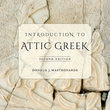 Accentuation Tutorial
Accentuation Tutorial

|
TOPICS Accent and Accent-Marking in Ancient Greek The Last 3 Syllables and the Accents Multiple Clitics Persistent Accentuation |
As noted previously, a proclitic, which ordinarily lacks an accent, receives an acute accent when it is followed by an enclitic. acute added to proclitic with enclitic following: εἴ τις ἀδικοίη... – “If anyone should act unjustly...” Various treatments of the accentuation of enclitics in series may be found in Greek manuscripts. The convention followed in most printed texts today (which may not reflect the realities of ancient pronunciation) is that each enclitic in a series except the last receives an acute accent on its final syllable. (This convention sometimes produces a violation of the general rule of contonation, since there is no allowance for the return to standard pitch when two consecutive syllables have acute accents.) The head word preceding the series of enclitics is treated in the same way as previously described for a head word with a single enclitic. (In the following examples, the enclitic words are underlined.) βάλλει τίς τινά τῳ. – “Someone is striking someone with something.”; first two of the three enclitics in the series receive acute on U εἴ τί τινα βλάπτεις... – “If you are doing any harm to anyone...”; first of two enclitics in series receives acute on U; preceding proclitic also receives acute αἵ γέ μοι δοκοῦσιν ἡδοναὶ ἀληθεῖς εἶναι πεύσῃ. – “You will hear the pleasures that seem to me to be genuine.”; first of two enclitics in series receives acute on U |
||||